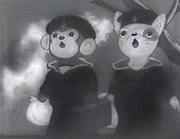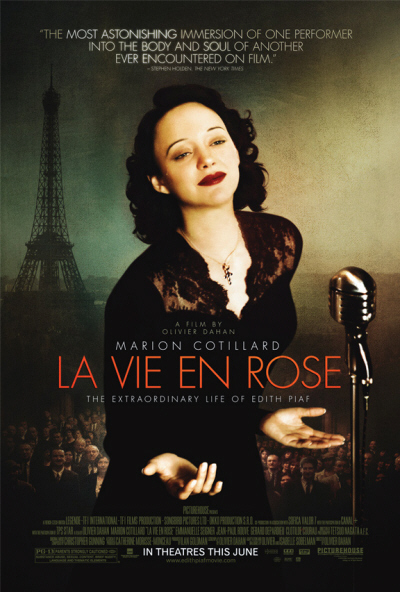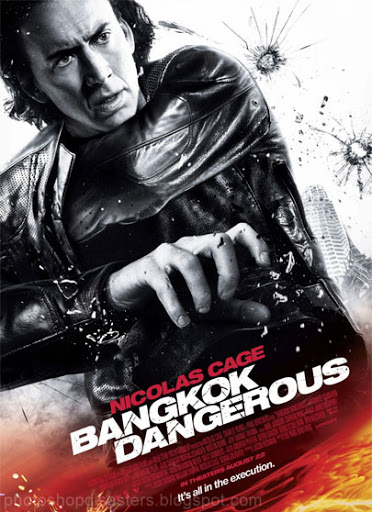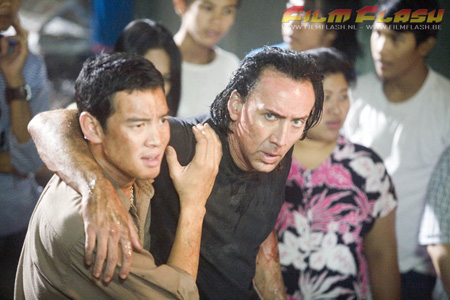


Anime (アニメ? taken from half of the Japanese pronunciation of "animation", pronounced [anime] ![]() listen (help·info) in Japanese, but typically pronounced /ˈænɪmeɪ/ or /ˈænɪmə/ in English) is animation in Japan and considered to be "Japanese animation" in the rest of the world.[1] Anime dates from about 1917.[2]
listen (help·info) in Japanese, but typically pronounced /ˈænɪmeɪ/ or /ˈænɪmə/ in English) is animation in Japan and considered to be "Japanese animation" in the rest of the world.[1] Anime dates from about 1917.[2]
Anime, in addition to manga (Japanese comics), is extremely popular in Japan and well known throughout the world. Anime itself is considered a form of limited animation. Anime can be released either by television broadcast or released directly to video, in which case it is often called OVA or OAV (Original Animation Video).
Anime can be hand-drawn or computer animated. It is used in television series, films, video, video games, commercials, and internet-based releases, and represents most, if not all, genres of fiction.
History
Anime began at the start of the 20th century, when Japanese filmmakers experimented with the animation techniques that were being explored in France, Germany, the United States, and Russia.[3] The oldest known anime in existence was screened in 1917 - a two minute clip of a samurai trying to test a new sword on his target, only to suffer defeat.[4]
By the 1930s, animation became an alternative format of storytelling compared to the underdeveloped live-action industry in Japan. Unlike in the United States, the live-action industry in Japan remained a small market and suffered from budgeting, location, and casting restrictions. The lack of Western-looking actors, for example, made it next to impossible to shoot films set in Europe, America, or fantasy worlds that do not naturally involve Japan. Animation allowed artists to create any characters and settings.[5]
The success of Disney's 1937 feature film Snow White and the Seven Dwarfs influenced Japanese animators.[6] In the 60's, Osamu Tezuka adapted and simplified many Disney animation techniques to reduce the costs and number of frames in the production. This was intended to be a temporary measure to allow him to produce material on a tight schedule with an inexperienced animation staff.
During the 1970s, there was a surge of growth in the popularity of manga—which were often later animated—especially those of Osamu Tezuka, who has been called a "legend"[7] and the "god of manga".[8][9] His work and that of other pioneers in the field, inspired characteristics and genres that are fundamental elements of anime today. The giant robot genre (known as "Mecha" outside Japan), for instance, took shape under Tezuka, developed into the Super Robot genre under Go Nagai and others, and was revolutionized at the end of the decade by Yoshiyuki Tomino who developed the Real Robot genre. Robot anime like the Gundam and Macross series became instant classics in the 1980s, and the robot genre of anime is still one of the most common in Japan and worldwide today. In the 1980s, anime became more accepted in the mainstream in Japan (although less than manga), and experienced a boom in production. Following a few successful adaptations of anime in overseas markets in the 1980s, anime gained increased acceptance in those markets in the 1990s and even more in the 2000s.
Terminology
In Japanese, the English term animation is written in katakana as アニメーション (animēshon, pronounced [ɑnimeːɕoɴ]), and the term anime (アニメ) emerged in the 1970s as an abbreviation, though some state that the abbreviated word is based on the French word l'animé.[3][10] Both the original and abbreviated forms are valid and interchangeable in Japanese, but the shorter form is more commonly used.
The pronunciation of anime in Japanese, ɑnime, differs significantly from the Standard English IPA: /ˈænɪmeɪ/ which have different vowels and stress. (In Japanese each mora carries equal stress.) As with a few other Japanese words such as saké, Pokémon, and Kobo Abé, anime is sometimes spelled animé in English (as in French), with an acute accent over the final e, to cue the reader that the letter is pronounced, not silent as would be expected in English. However, this accent does not appear in any commonly used system of romanized Japanese and is not in frequent enough use to be recognized by the Oxford English Dictionary.
Word usage
In Japan, the term does not specify an animation's nation of origin or style; instead, it is used as a blanket term to refer to all forms of animation from around the world.[11][12] In English, dictionary sources define anime as "a Japanese style of motion-picture animation" or "a style of animation developed in Japan".[13] Non-Japanese works that borrow stylization from anime is commonly referred to as "anime-influenced animation" but it is not unusual for a viewer who does not know the country of origin of such material to refer to it as simply "anime". Some works are co-productions with non-Japanese companies, such as the Cartoon Network and Production I.G series IGPX or Ōban Star-Racers, which may or may not be considered anime by different viewers.
In English, anime can be used as a common noun ("Do you watch anime?") or as a suppletive adjective ("The anime Guyver is different from the movie Guyver"). It may also be used as a mass noun, as in "How much anime have you collected?", though it is sometimes incorrectly pluralized as animes because of the Japanese language's lack of grammatical number.[14]
Synonyms
Anime is occasionally referred to as Japanimation, but this term has fallen into disuse.[15] Japanimation saw the most usage during the 1970s and 1980s, but was supplanted by anime in the mid-1990s as the material became more widely known in English-speaking countries.[16] In general, the term now only appears in nostalgic contexts.[16] Although the term was coined outside Japan to refer to animation imported from Japan, it is now used primarily in Japan, to refer to domestic animation; since anime does not identify the country of origin in Japanese usage, Japanimation is used to distinguish Japanese work from that of the rest of the world.[16]
In Japan, manga can additionally refer to both animation and comics (although the use of manga to refer to animation is mostly restricted to non-fans).[citation needed] Among English speakers, manga usually has the stricter meaning of "Japanese comics".[citation needed] An alternate explanation is that it is due to the prominence of Manga Entertainment, a distributor of anime to the US and UK markets. Because Manga Entertainment originated in the UK the use of the term is common outside of Japan.[citation needed] The term "animanga" has been used to collectively refer to anime and manga, though it is also a term used to describe comics produced from animation cels.
Visual characteristics
Anime is commonly referred to as an art form.[17] As a visual medium, it naturally places a large emphasis on visual styles. The styles can vary from artist to artist or by studio to studio. Some titles make extensive use of common stylization: FLCL, for example, is known for its wild, exaggerated stylization. In contrast, titles such as Only Yesterday or Jin-Roh take much more realistic approaches, featuring few stylistic exaggerations.While different titles and different artists have their own artistic styles, many stylistic elements have become so common such that they are described as being definitive of anime in general. However, this does not mean that all modern anime share one strict, common art style. Many anime have a very different art style from what would commonly be called "anime style", yet fans still use the word "anime" to refer to these titles. Generally, the most common form of anime drawings are "exaggerated physical features such as large eyes, big hair and elongated limbs... and dramatically shaped speech bubbles, speed lines and onomatopoeic, exclamatory typography."[18]
The influences of Japanese calligraphy and Japanese painting also characterize linear qualities of the anime style. The round Ink brush traditionally used for writing Kanji and for painting produces a stroke of widely varying thickness.
Anime also tends to borrow many elements from manga including text in the background, and borrowing panel layouts from the manga as well. For example, an opening may employ manga panels to tell the story, or to dramatize a point for humorous effect. This is best demonstrated in the anime Kare Kano.
Character design
| The neutrality of this section is disputed. Please see the discussion on the talk page. (May 2008) Please do not remove this message until the dispute is resolved. |
Body proportions emulated in anime come from proportions of the human body. The height of the head is considered as the base unit of proportion. Head heights can vary as long as the remainder of the body remains proportional. Most anime characters are about seven to eight heads tall, and extreme heights are set around nine heads tall.[19]
Variations to proportion can be modded. Super deformed characters feature a non-proportionally small body compared to the head. Sometimes specific body parts, like legs, are shortened or elongated for added emphasis. Mostly super deformed characters are two to four heads tall. Some anime works like Crayon Shin-chan completely disregard these proportions. It is enough such that it resembles a Western cartoon. For exaggeration, certain body features are increased in proportion.[19]
A common approach is the large eyes style drawn on many anime and manga characters. Osamu Tezuka was inspired by the exaggerated features of American cartoon characters such as Betty Boop, Mickey Mouse, and Disney's Bambi.[3][20] Tezuka found that large eyes style allowed his characters to show emotions distinctly. When Tezuka began drawing Ribbon no Kishi, the first manga specifically targeted at young girls, Tezuka further exaggerated the size of the characters' eyes. Indeed, through Ribbon no Kishi, Tezuka set a stylistic template that later shōjo artists tended to follow.
Coloring is added to give eyes, particularly the cornea, and some depth. The depth is accomplished by applying variable color shading. Generally, a mixture of a light shade, the tone color, and a dark shade is used.[21][22] Cultural anthropologist Matt Thorn argues that Japanese animators and audiences do not perceive such stylized eyes as inherently more or less foreign.[5]
However, not all anime have large eyes. For example Hayao Miyazaki is known for not having large eyes and having realistic hair colors on his characters.[23] In addition many other productions also have been known to use smaller eyes. This design tends to have more resemblance to traditional Japanese art. Some characters have even smaller eyes, where simple black dots are used.
A wide variety of facial expressions are used by characters to denote moods and thoughts.[24] Anime uses a different set of facial expressions in comparison to western animation.
Other stylistic elements are common as well; often in comedic anime, characters that are shocked or surprised will perform a "face fault", in which they display an extremely exaggerated expression. Angry characters may exhibit a "vein" or "stressmark" effect, where lines representing bulging veins will appear on their forehead. Angry women will sometimes summon a mallet from nowhere and strike someone with it, leading to the concept of Hammerspace and cartoon physics. Male characters will develop a bloody nose around their female love interests (typically to indicate arousal, based on an old wives' tale).[25] Embarrassed characters either produce a massive sweat-drop (which has become one of the most widely recognized stereotype motifs of anime) or produce a visibly red blush beneath the eyes, especially as a manifestation of repressed romantic feelings. While common, the use of face faults is optional. Some anime, usually with political plots and other more serious subject matters, have abandoned the use of face faults such as Gundam Wing and Teknoman.
Animation technique
Like all animation, the production processes of storyboarding, voice acting, character design, cel production and so on still apply. With improvements in computer technology, computer animation increased the efficiency of the whole production process.
Anime is often considered a form of limited animation. That means that stylistically, even in bigger productions the conventions of limited animation are used to fool the eye into thinking there is more movement than there is.[3] Many of the techniques used are comprised with cost-cutting measures while working under a set budget.
Anime scenes place emphasis on achieving three-dimensional views. Backgrounds depict the scenes' atmosphere.[3] For example, anime often puts emphasis on changing seasons, as can be seen in numerous anime, such as Tenchi Muyo. Sometimes actual settings have been duplicated into an anime. The backgrounds for the Melancholy of Haruhi Suzumiya are based on various locations within the suburb of Nishinomiya, Hyogo, Japan.[26]
Camera angles, camera movement, and lighting play an important role in scenes. Directors often have the discretion of determining viewing angles for scenes, particularly regarding backgrounds. In addition, camera angles show perspective.[27] Directors can also choose camera effects within cinematography, such as panning, zooming, facial closeup, and panoramic.[28]
The large majority of anime is traditional animation, which better allows for the division of labour, pose to pose approach and checking of drawings before they are shot favoured by the industry.[29] Other mediums are mostly limited to independently-made short films,[30] examples of which are the silhouette and other cutout animation of Noburo Ofuji,[29][31] the stop motion puppet animation of Tadahito Mochinaga, Kihachirō Kawamoto[32] and Tomoyasu Murata[33] and the computer animation of Satoshi Tomioka[34] (most famously Usavich).[35]
Distribution
- See also: Anime licensing
While anime had entered markets beyond Japan in the 1960s, it grew as a major cultural export during its market expansion during the 1980s and 1990s. The anime market for the United States alone is "worth approximately $4.35 billion, according to the Japan External Trade Organization".[36] Anime has also been a commercial success in Asia, Europe and Latin America, where anime has become even more mainstream than in the United States. For example, the Saint Seiya video game was released in Europe due to the popularity of the show even years after the series has been off-air.
Anime distribution companies handled the licensing and distribution of anime beyond Japan. Licensed anime is modified by distributors through dubbing into the language of the country and adding language subtitles to the Japanese language track. Using a similar global distribution pattern as Hollywood, the world is divided into five regions.
Some editing of cultural references may occur to better follow the references of the non-Japanese culture.[37] Certain companies may remove any objectionable content, complying with domestic law. This editing process was far more prevalent in the past (e.g. Robotech), but its use has declined because of the demand for anime in its original form. This "light touch" approach to localization has favored viewers formerly unfamiliar with anime. The use of such methods is evident by the success of Naruto and Cartoon Network's Adult Swim programming block, both of which employ minor edits.[citation needed]
With the advent of DVD, it was possible to include multiple language tracks into a simple product. This was not the case with VHS cassette, in which separate VHS media were used and with each VHS cassette priced the same as a single DVD. The "light touch" approach also applies to DVD releases as they often include both the dubbed audio and the original Japanese audio with subtitles, typically unedited. Anime edited for television is usually released on DVD "uncut," with all scenes intact.
TV networks regularly broadcast anime programming. In Japan, major national TV networks, such as TV Tokyo broadcast anime regularly. Smaller regional stations broadcast anime under the UHF. In the United States, cable TV channels such as Cartoon Network, Disney, Sci-Fi, and others dedicate some of their time slots for anime. Then the Anime Network specifically shows anime. Sony based Animax and Disney's Jetix channel broadcast anime within many countries in the world. AnimeCentral solely broadcast's Anime in the UK.
Although it is a violation of copyright laws in many countries, some fans add subtitles to anime on their own. These are distributed as fansubs. The ethical implications of producing, distributing, or watching fansubs are topics of much controversy even when fansub groups do not profit from their activities. Once the series has been licensed outside of Japan, fansub groups often cease distribution of their work. In one case, Media Factory Incorporated requested that no fansubs of their material be made, which was respected by the fansub community.[38] In another instance, Bandai specifically thanked fansubbers for their role in helping to make The Melancholy of Haruhi Suzumiya popular in the English speaking world.[39]
The Internet had played a significant role in the exposure of anime beyond Japan. Prior to the 1990s, anime has had limited exposure beyond Japan's borders. Coincidentally, as the popularity of the Internet grew, so did interest in anime. Much of the fandom of anime grew through the Internet. The combination of internet communities and increasing amounts of anime material, from video to images, helped spur the growth of fandom.[40] As the Internet gained more widespread use, Internet advertising revenues grew from 1.6 billion yen to over 180 billion yen between 1995 and 2005.[41]
Influence on world culture
Anime has become commercially profitable in western countries as early commercially successful western adaptations of anime, such as Astro Boy, have revealed.[42] The phenomenal success of Nintendo's multi-billion dollar Pokémon franchise[43] was helped greatly by the spin-off anime series that, first broadcast in the late 1990s, is still running worldwide to this day. In doing so, anime has made significant impacts upon Western culture. Since the 19th century, many Westerners have expressed a particular interest towards Japan. Anime dramatically exposed more Westerners to the culture of Japan. Aside from anime, other facets of Japanese culture increased in popularity.[44] Worldwide, the number of people studying Japanese increased. In 1984, the Japanese Language Profiency test was devised to meet increasing demand.[45] Anime-influenced animation refers to non-Japanese works of animation that emulate the visual style of anime.[46] Most of these works are created by studios in the United States, Europe, and non-Japanese Asia; and they generally incorporate stylizations, methods, and gags described in anime physics, as in the case of Avatar: The Last Airbender. Often, production crews either are fans of anime or are required to view anime.[47] Some creators cite anime as a source of inspiration with their own series.[48][49] Furthermore, a French production team for Ōban Star-Racers moved to Tokyo to collaborate with a Japanese production team from Hal Film Maker.[50] Critics and the general anime fanbase do not consider them as anime.[51]
Some American animated television series have singled out anime styling with satirical intent, for example South Park (with "Chinpokomon" and "Good Times With Weapons"). South Park has a notable drawing style, which was itself parodied in "Brittle Bullet", the fifth episode of the anime FLCL, released several months after "Chinpokomon" aired. This intent on satirizing anime is the springboard for the basic premise of Kappa Mikey, a Nicktoons Network original cartoon. Even cliches normally found in anime are parodied in Perfect Hair Forever. Anime conventions began to appear in the early 1990s, during the Anime boom, starting with Anime Expo, Animethon, Otakon, and JACON. Currently anime conventions are held annually in various cities across the Americas, Asia, and Europe.[52] Many attendees participate in cosplay, where they dress up as anime characters. Also, guests from Japan ranging from artists, directors, and music groups are invited. In addition to anime conventions, anime clubs have become prevalent in colleges, high schools, and community centers as a was to publicly exhibit anime as well as broadening Japanese cultural understanding.[53]
Anime and American audiences
The Japanese term otaku is used in America as a term for anime fans, more particularly the obsessive ones. The negative connotations associated with the word in Japan have also been lost in its American context, where it instead connotes the pride of the fans. Only in the recent decade or so has there been a more casual viewership outside the devoted otaku fan base, which can be attributed highly to technological advances. Also, shows like Pokémon and Dragon Ball Z provided a pivotal introduction of anime's conventions, animation methods, and Shinto influences to many American children. Because anime is highly influenced by ancient Japanese myths often deriving from the animistic nature worship of Shinto, most American audiences not accustomed to anime are wholly unfamiliar to these foreign texts and customs. For example, an average American viewing the live-action TV show Hercules will be no stranger to the Greek myths and legends it is based on, while the same person watching the show Tenchi Muyo might not understand that the pleated ropes wrapped around the "space trees" are influenced by the ancient legend of Amaterasu and Susano.[54]
It is also important to note that the Western world abandoned their ancient pagan beliefs during the middle ages, whereas Shinto has remained relatively unchanged in modern Japanese culture. Because of this, Shinto has been able to provide over eight million deities and their surrounding folklore for anime creators to utilize. A Japanese audience is thus more aware of the these Shinto influences since they have existed consistently throughout Japanese society. American media creators are often confined with the most popular or basic myths to draw upon, like Adam and Eve.[55] These cultural gaps limit anime's potential impact on its foreign audience, but as anime integrates into American pop-culture the newer generations will be more in tune with anime conventions and the ideals behind Shinto.
Source : http://en.wikipedia.org/wiki/Anime








